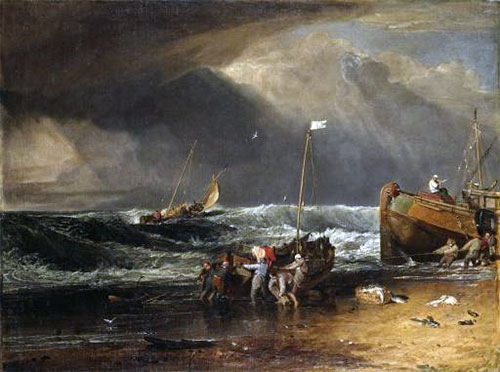Küstenlandschaft mit Fischern, die ein Boot an Land ziehen (The Iveagh Seapiece), c.1803/04 Joseph Mallord William Turner (1775-1851)
Standort: Tate Gallery London UKOriginalmaß: 91.4 x 122 cm
Ölgemälde Reproduktion
Wenn Sie eine andere Größe als die angebotene wünschen
Beschreibung
Gemalt von europäischen Künstlern mit akademischer Ausbildung
Museumsqualität
+ 4 cm Spielraum zum Dehnen
Erstellungszeit: 8-9 Wochen
Erstellungsprozess
Wir schaffen unsere Gemälde in Museumsqualität und unter Berücksichtigung höchster akademischer Standards. Die Gemälde-Reproduktion wird vollständig mit Ölfarben auf eine leere Leinwand gemalt. Wir fügen zusätzlich 4 cm leeren Abstand über die angebotene Gröβe hinzu, welche für strecken der Leinwand auf den Keilrahmen benutzt werden.
Die Schaffung Ihrer Joseph Mallord William Turner nimmt Zeit in Anspruch. Das Bild sollte nicht zu schnell gemalt werden, man sollte keinen Fristen hinterherjagen. Das Bild benötigt Zeit, um hohe Qualität und Detailtreue zu erreichen, sowie um vollständig versandbereit zu trocknen. Abhängig vom Aufwand, von der Detailgetreue und Bildgröße, brauchen wir 8-9 Wochen, um das Bild fertig zu stellen.
Wenn eine Änderung in Bezug auf die Frist notwendig sein sollte, oder sollte Ihre Bestellung in einer für uns äuβerst belebten Periode aufgegeben werden, werden wir Sie per E-Mail über die, von uns für Ihre Reproduktion gebrauchte Zeit, informiert.
Wir rahmen unsere Ölgemälde-Reproduktionen nicht ein. Die Ölgemälde sind ein kostenaufwendiges Produkt, und die Gefahr einer Beschädigung eines im Rahmen gespannten Gemäldes während des Transportes ist äuβerst hoch.
Außerdem gibt es postalische Beschränkungen bezüglich der Größe der Sendung.
Darüber hinaus kann der Versandpreis aufgrund der Abmessungen der gespannten Leinwand den Preis des Produkts selbst übersteigen.
Sie können Ihr Gemälde in Ihrem örtlichen Rahmengeschäft aufspannen und einrahmen.
Versand
Sobald das Gemälde Küstenlandschaft mit Fischern, die ein Boot an Land ziehen (The Iveagh Seapiece) fertig und trocken ist, wird es an Ihre Lieferadresse versendet.
Wir bieten kostenlosen Versand sowie kostenpflichtige Express-Transportdienste an.
Die Leinwand es eingerollt, in einem festen und sicheren Versandrohr. Sie können den Versandpreis mit dem Tool Geschätzte Steuern und Versandgebühren überprüfen.
Museumsqualität
TOPofART Gemälden stellen wir nur mit Museumsqualität her. Unsere Künstler mit akademischer Ausbildung lassen keine Kompromisse in Bezug auf die Qualität und der Detailtreue des bestellten Gemäldes zu. Wir pflegen keine Zusammenarbeit und werden nie eine solche mit Ateliers mit niedriger Qualität aus dem Fernen Osten zulassen. Wir sind in Europa ansässig, und Qualität ist unsere leitende Priorität.
Zusätzliche Information
Über den Himmel hinaus zieht die Komposition des Gemäldes den Betrachter in einen lebhaften Austausch zwischen den Figuren an Land und dem Tumult auf dem Meer. Ganz rechts vereinen sich Fischer in einem gemeinsamen Ziel und kämpfen mit Seilen, während sie ihr Boot aus der Gischt ziehen. Ihre Haltung und kollektive Anstrengung stehen im Kontrast zu dem Boot in unsicherem Winkel in der rollenden Brandung auf der gegenüberliegenden Seite, was auf einen ungewisseren Kampf hindeutet. Diagonale Linien von Masten und Seilen durchschneiden den Horizont, verstärken das Gefühl von Bewegung und binden beide Seiten des Gemäldes zusammen.
Ein wesentlicher Teil der Kraft des Gemäldes liegt in Turners Pinselführung. Im wogenden Wasser sind die Striche geschichtet und spontan und fangen die ständige Bewegung des Meeres ein. Schaum und Wellenkämme wirken unmittelbar, ihre Formen werden durch schnelle Bewegungen der Farbe modelliert. Doch es gibt auch einen präzisen, fast zurückhaltenden Auftrag, bei dem die Figuren, Boote und die Küstenlinie mit fester Klarheit hervortreten und uns daran erinnern, dass es sich immer noch um eine genau beobachtete Szene und nicht um ein reines atmosphärisches Experiment handelt.
Was das Thema selbst betrifft, so zeigt das Gemälde Fischer, die angesichts einer unerbittlichen Flut um ihren Fang kämpfen, während ein zweites Boot auf dem Wellenkamm schwankt. Es ist ein Drama der alltäglichen Mühsal, verankert durch das kraftvolle Thema Mensch gegen Natur. Der Blick wird sanft von den körnigen Details der Küstenlinie zum wogenden Himmel darüber geführt und nimmt das menschliche Element in einem größeren, elementaren Schauspiel auf.
Ein Blick auf den breiteren Kontext zeigt, wie dieses Werk mit maritimen Traditionen im Dialog steht, die von niederländischen Malern des 17. Jahrhunderts geprägt wurden, deren Werke ebenfalls in Sammlungen zu finden sind, die mit der Herkunft dieses Gemäldes in Verbindung stehen. Turners Darstellung von wirbelnden Wolken und aufgewühltem Meer zeigt sein Interesse daran, diese nordeuropäische Ästhetik in einen emotionaleren Bereich zu erweitern. Die Wahl dieses Gemäldes für ein Vermächtnis zeugt von der anhaltenden Faszination für Seestücke, insbesondere bei Sammlern, die sich für das Segeln begeistern, und von Turners Erfolg, strenge Beobachtung mit romantischem Ausdruck zu verbinden.
1 Reviews
5.00 Gesamtbewertung
The Society of Painters in Water-Colors (later the Old Water-Color Society) was founded in 1802, and Turner was a prime force behind its establishment although he never became a member. The aim was to show watercolor as a medium equal to oil in the historical genre, to combine figures and grandiose landscape in heroic style. Girtin and Turner, traditionally considered the fathers of British watercolor, were firmly rooted in the importance of observation. Turner's Study of Fish: Two Tench, a Trout and a Perch (1822) and Head of a Heron (1815) are watercolor studies of natural phenomena - the pattern and reflection of the types of fish, the plumage on the bird's head. Observation of such realistic detail would be seen again in paintings of High Victorian realism and in the minutiae of Pre-Raphaelitism. During the 1820s and 1830s, Turner illustrated a number of topographical books. The most ambitious, Picturesque Views in England and Wales, was not a financial success: travel on the Continent was again possible, and whilst the eighteenth-century traveler had visited the classical sites, the nineteenth-century middle-class tourist was more interested in novelty and exoticism.
In oil, as in watercolor, Turner explored mythological, biblical, historical and marine painting, while developing a theory of color association and an examination of light that would fascinate the Impressionists. The origins of his most famous early history piece, Snow Storm: Hannibal and His Army Crossing the Alps (1812), and his shipwrecks lay in Burke's theory of the sublime, which gave precedence over ideal beauty to pictorial effects that produced the strongest emotion. At the same time, Turner was painting British landscape in Ideal form, for example Richmond Hill on the Prince Regent's Birthday (1819).This search for subliminal naturalism lies behind much of his work, whether in the swirling waves of his 'shock' oil paintings of shipwrecks and sea storms or in the study of light and pure color in his watercolors.






